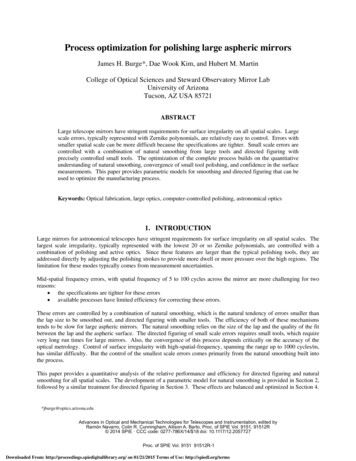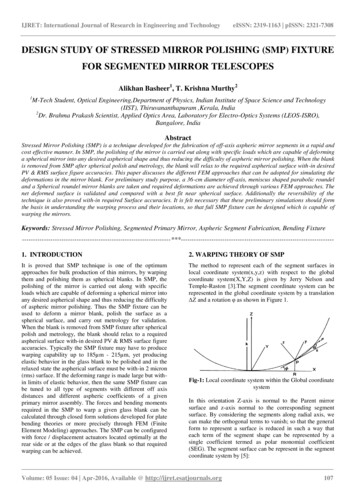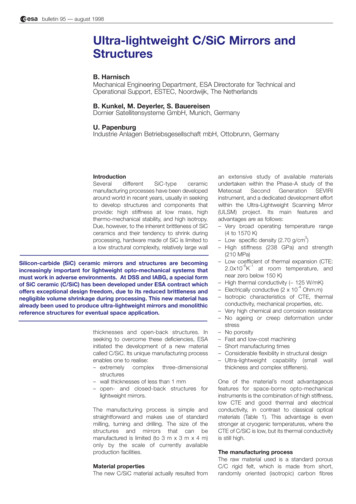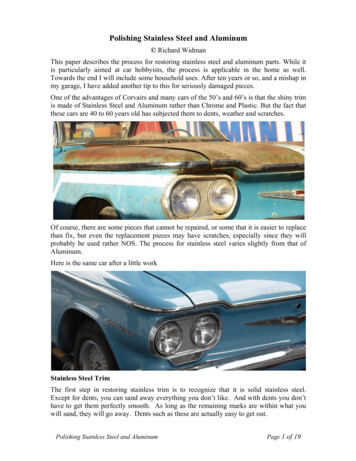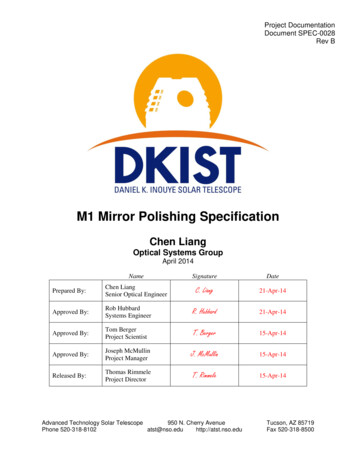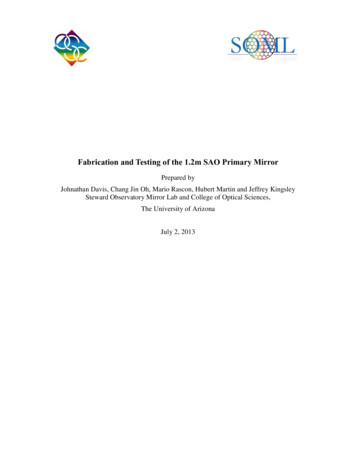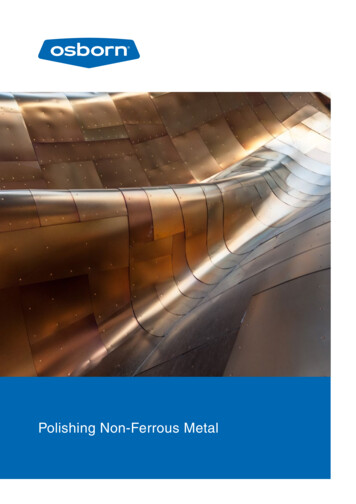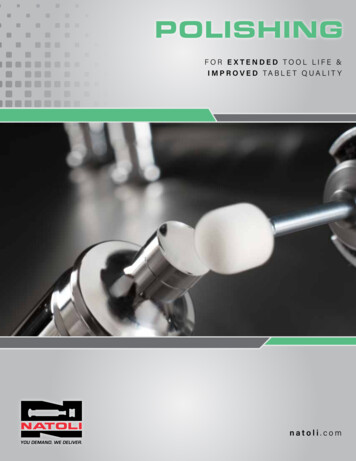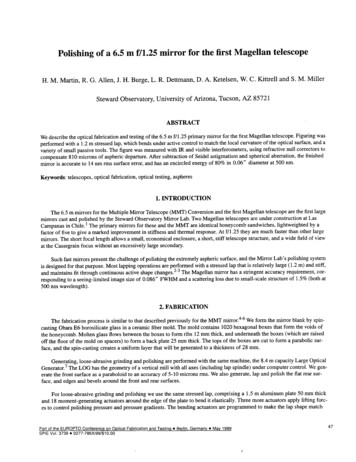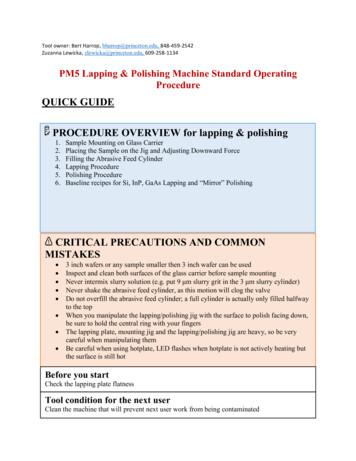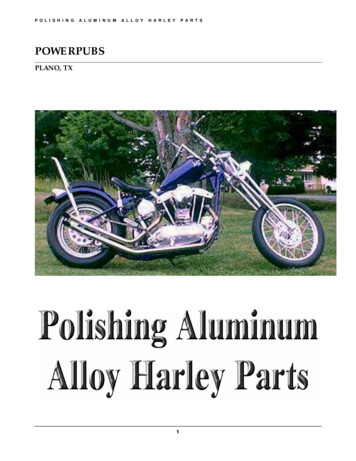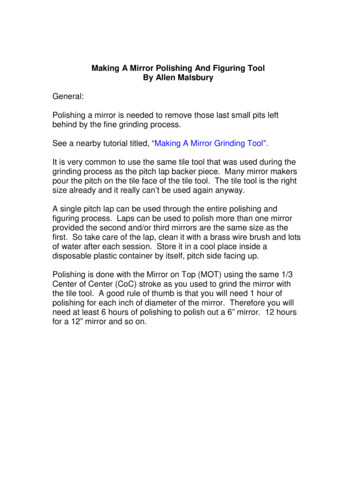
Transcription
Making A Mirror Polishing And Figuring ToolBy Allen MalsburyGeneral:Polishing a mirror is needed to remove those last small pits leftbehind by the fine grinding process.See a nearby tutorial titled, “Making A Mirror Grinding Tool”.It is very common to use the same tile tool that was used during thegrinding process as the pitch lap backer piece. Many mirror makerspour the pitch on the tile face of the tile tool. The tile tool is the rightsize already and it really can’t be used again anyway.A single pitch lap can be used through the entire polishing andfiguring process. Laps can be used to polish more than one mirrorprovided the second and/or third mirrors are the same size as thefirst. So take care of the lap, clean it with a brass wire brush and lotsof water after each session. Store it in a cool place inside adisposable plastic container by itself, pitch side facing up.Polishing is done with the Mirror on Top (MOT) using the same 1/3Center of Center (CoC) stroke as you used to grind the mirror withthe tile tool. A good rule of thumb is that you will need 1 hour ofpolishing for each inch of diameter of the mirror. Therefore you willneed at least 6 hours of polishing to polish out a 6” mirror. 12 hoursfor a 12” mirror and so on.
1. To make the lap you will need optical grade pitch. Pitchcomes in differing harnesses. #64 is a common grade forsmall mirrors. Break up the solid pitch by tapping on theoutside of the pitch container with a hammer. Do this with thewhite lid in place to keep the pitch chips in the container.
2. Pour pitch pieces into a disposable aluminum pan. Cover it.Use an electric hot plate to heat the pitch. DO NOT heat withan open flame gas burner or on the gas stove. The pitch is amixture of different hydrocarbon compounds. As you heat it,combustible compounds are released. Given the rightconditions, these combustible compounds can be ignited by anearby flame. Work outdoors. Pitch smells a lot like a newasphalt driveway as it is heated. Work in old clothes, there isa very good chance you will get some melted pitch on yousomewhere. Wear gloves too.
3. While the pitch is melting into a liquid, make a dam aroundthe used tile tool using masking tape. (In this picture a newbacker was formed using dental plaster without tile on it.)Go around twice with the sticky side in. Make sure the end ofthe tape is doubled over on itself so you can find the endeasily. This will be important later. Set this on a LEVELsurface so when you pour the liquefied pitch inside the dam, itwill spread out to a uniform thickness
4. Rub a few drops of vegetable oil onto the mirror face. The oilhelps to stick the foil to the glass. It also helps when you willbe slipping the mirror off the foil in a later step.
5. Place the mirror face up on a flat and steady surface. Coverthe oiled face of the mirror with aluminum foil. Rub and makethe aluminum foil smooth over the entire mirror face.
6. Check to see if the pitch is melting. Stirring with a woodenstick helps get the last lumps to melt.
7. Once the pitch has completely melted and is a liquid, pour it ontothe face of the backing piece. Pour onto the center. The pitch willflow to the edges quickly. You may get some bubbles. Don’t try tofix them.
8. Here is the tricky part. You must wait until the pitch cools and getshard enough to pull the tape off, but NOT so long that it is too hardand no longer a soft plastic-like material. (Press in gently on thepitch through the tape along the edge. If it springs back immediately, it is still a liquid. If it is slow to spring back, it is getting moreplastic-like and nearly ready.) The tape must be removed by a series of quick ripping movements. Rip around 1/8 the circumference each stroke. Like you were removing a ban-aid. It shouldcome off cleanly.
9. Now, pick up the lap without touching the pitch. Turn it upsidedown and press it down while CENTERED over the foil-coveredmirror face. Some pitch should be bulge out all the way around.Gently pick up the sandwich you have made and get it into somecool water quickly. Don’t squeeze it together any more. Also,remember the mirror was coated with oil. It may slip out easily.Hold on to all the parts when moving the sandwich. I often justwalk back inside and run water over it in the kitchen sink. Havinga cool bucket of water nearby works also.
10. Once the pitch is somewhat hard, you can gently separate themirror from the foil by sliding it SIDEWAYS and off the edge. Ifyou try to pull or pry them apart you will make a dent in the pitch,or worse, pull the soft pitch off the backer. Here is a photoshowing the lap after the mirror has been removed and thealuminum foil peeled off too.
11. After you have cleaned up the pitch pouring area and the laphas cooled completely, trim the pitch back to the edge of thebacker. A sharp striking stroke is best for this. You will CHIPaway the pitch. (It is quite brittle at room temperate.) A strokemuch like striking a wood match is about right for this. Aim forthe hard edge where the pitch meets the backer. Keep otherfingers clear of the strike zone. Wear gloves. Your skin is warmenough to re-soften the pitch chips. Small chips will stick to yourhands and arms. They are not easily removed.
12.Next, cut facets into the laps. Use masking tape to markwhere you will cut the facets at the tape’s edge. Use a singleedge razor blade to scratch a “V” groove all the way across thelap. Try to make the first set of grooves about ¾” to 1” apart.Some mirror makers like to offset the first facet slightly offcenter. They believe a symmetric pattern of grooves is lesslikely to create a nice spherical polish and that a more randompattern is better.
13.Use a BRASS wire bush to clean out the groovesbetween the facets as you cut them. Brass is better than asteel or stainless steel brush when working around glass. If apiece of the steel brush breaks off or becomes imbedded in thepitch, it will scratch the mirror next session. Brass will not. Thegrooves should be “V” shaped.
14. Cut more grooves at right angles to the first set. A “waffle”pattern results. Brush again, and you are ready for pressingbefore polishing.
15. Pressing the pitch lap is important and is needed to achieve goodcontact between the pitch lap and the mirror. Here is a smallmirror and lap being pressed together by the weight of a plasticbottle with ten pounds of water in it. That’s five quarts. Tenpounds is the right weight for a 4” to 6” mirror.
There are two types of pressing: “Cold” and “Hot”.You cold press before starting each polishing session. Coldpressing is done for at least 5 minutes. You also cold pressANYTIME you “feel” a lack of contact during polishing. I coldpress at every 10 to 15 minutes during polishing. This gives myarms a rest, and it keeps the evil poor contact from occurring.Polishing with poor contact will goof up your nice sphericalsurface. It may take a long time doing 1/3 CoC to fix a fewminutes of poor contact polishing.To cold or hot press, you place the mirror face up on a level surface. Apply a thin layer of Cerium Oxide slurry to the mirror’sface and spread it with your gloved finger. THIS IS IMPORTANT.If you forget the Cerium Oxide, the pitch will stick to the mirrorface and you will not be able to get the pitch lap off the mirrorface at the end of pressing.Cold pressing is done at room temperature.Hot pressing is done before using a new lap or when you can’tachieve good contact with a cold press for some reason. To hotpress, immerse the entire pitch lap in a pan of very warm waterfor about a minute or two. (The water should not be so hot youcan’t put your hands in it.) Prepare the mirror with face up.Apply the Cerium Oxide slurry to the mirror face. DON’TFORGET THE CERIUM OXIDE SLURRY. Now place the pitchlap face down on the mirror face. Place the weight on the backof the lap backer. Wait two minutes. Remove the weight andseparate the mirror from the lap. Again, slide it off sideways.Now flip the positions to polish. The pitch lap should be on thebottom and Mirror on Top (MOT) for polishing. Use 1/3 CoCstrokes. After a hot press, you will have good contact.REMEMBER how the glass feels moving back and forth over themirror after the hot press. It should feel like a steady, uniformresistance. THAT IS GOOD CONTACT. When you stop feelinggood contact, ALWAYS STOP and cold press again.
The final step after polishing and figuring is the application of ahighly reflective coating. Almost all homemade telescopes arecoated with aluminum oxide. The aluminum oxide is overcoated with a transparent material that protects the aluminumoxide from corrosion. A mirror coating should last at least tenyears. At the time this is being written, it costs about 10 to 15 per inch of diameter for professionally applied coatings.Contact the author for referral to a local vendor.
Polishing with poor contact will goof up your nice spherical surface. It may take a long time doing 1/3 CoC to fix a few minutes of poor contact polishing. To cold or hot press, you place the mirror face up on a level sur-face. Apply a thin layer of Cerium Oxide slurry to the mirror’s face
